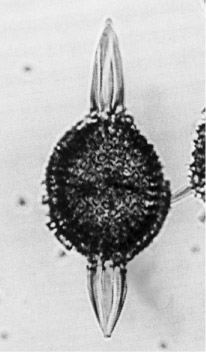 Spongatractus
balbis Sanfilippo and Riedel
Spongatractus
balbis Sanfilippo and Riedel Spongatractus
balbis Sanfilippo and Riedel
Spongatractus
balbis Sanfilippo and RiedelSpongatractus balbis Sanfilippo and Riedel, 1973, p.518, pl.2, figs.1-3, pl.25, figs.1-2
Cortical shell ellipsoidal, thick-walled, with subcircular pores (approximately 8-13 on the half-equator), joined to the double medullary shell by bars lying approximately in the equatorial plane, and usually two bars collinear with the polar spines. On the surface of the cortical shell are one to three layers of meshwork formed by connection of the distal ends of small superficial thorns. Two-bladed polar spines are somewhat variable in form and size, but are commonly robust, about half as long as the cortical shell, with a change in contour from parallel-sided proximally to tapered distally (Sanfilippo and Riedel, 1973).
Based on 25 specimens. Major diameter of cortical shell (excluding external layers) 105-150 µm, its minor diameter 65-145 µm. Maximum diameter of outer medullary shell 30-50 µm (Sanfilippo and Riedel, 1973).
S. balbis is distinguished from S. pachystylus by the lesser development of external meshwork, and from members of the Axoprunum pierinae (Clark and Campbell, 1942) group (Sanfilippo and Riedel, 1973) by the presence of meshwork on the cortical shell (Sanfilippo et al., 1985).
The thick-walled ellipsoidal cortical shell is covered by one to three layers of spongy meshwork, formed by connection of the distal ends of superficial thorns. The cortical shell has approximately 8-13 subcircular pores on the half-equator. Two bladed polar spines are variable in form and size, commonly robust, about half as long as the cortical shell, with a change in contour from parallel-sided proximally to tapered distally (Sanfilippo et al., 1985).
This species is found in localities from 30°S to 35°N, through most of the early Eocene, and earliest middle Eocene. Its morphotypic first appearance is approximately synchronous with the lower limit of the Buryella clinata Zone. Its evolutionary transition to Spongatractus pachystylus lies within the Phormocyrtis striata striata Zone.
Spongatractus balbis evidently evolved from the Axoprunum pierinae (Clark and Campbell) group (Sanfilippo and Riedel, 1973, p.488, pl.1, figs.6-12, pl.23, fig.3) and gave rise to S. pachystylus.